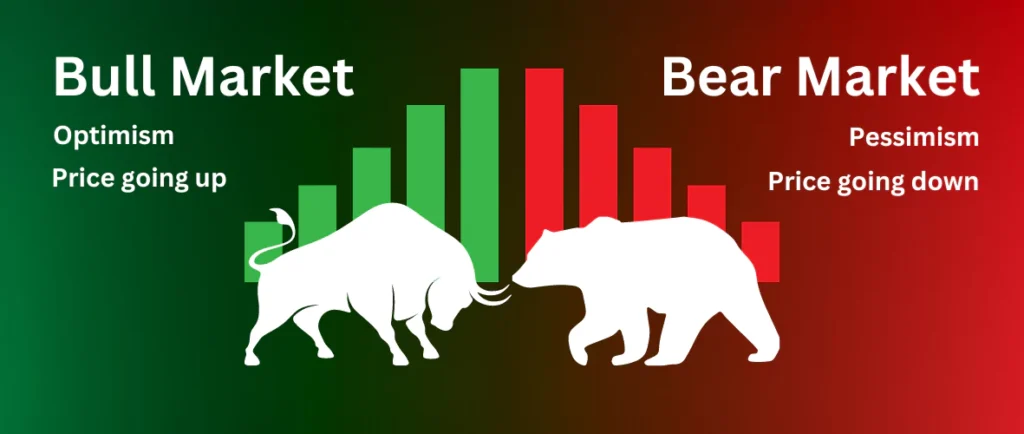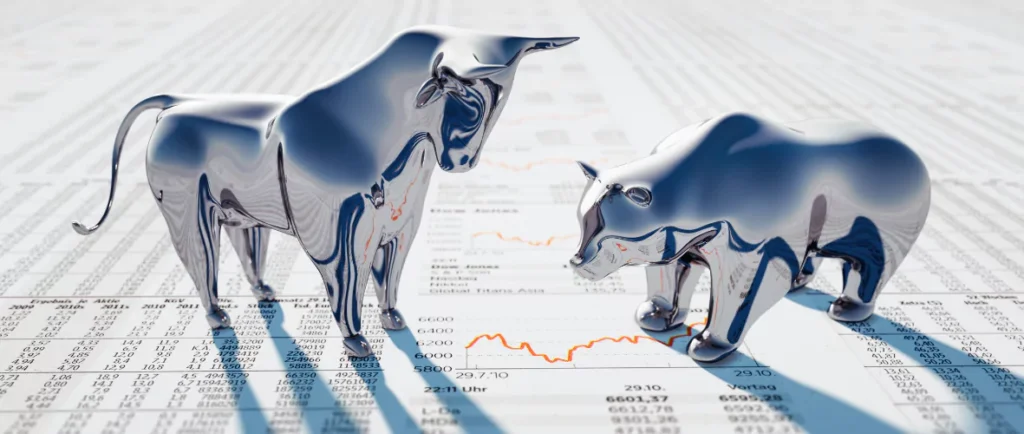Bull and bear markets are general descriptions of how financial markets are predicted to operate over time. A bull market refers to times of positive market sentiment in which investors are hopeful and stock values rise. A bear market, on the other hand, is characterized by negative sentiment, pessimism, and dropping share values. These alternating market cycles have a significant influence on investor behavior and the sorts of trading tactics that are preferred. In this article, we will look at the basic characteristics of bull and bear markets, the variables that drive them, and how investors should behave in each type of situation.
Defining Bull and Bear Markets

Bull and bear markets are often characterized retrospectively based on the long-term performance of a major market index or group of equities. One of the most widely used benchmarks is the S&P 500, which monitors the performance of 500 significant corporations listed on US stock exchanges. A bull market is defined as the S&P 500 rising at least 20% above a recent low point, whereas a bear market occurs when the S&P 500 falls by more than 20% from a recent high.
However, there is no single commonly recognized definition, and other indicators are often used to assess market sentiment and confirm trend reversals. Additional considerations include general stock volume and volatility, analyst views and earnings revisions, monetary policies, economic growth rates, interest rates, geopolitical circumstances, and other macroeconomic variables. Nonetheless, the 20% criteria serves as a basic recommendation, because opinion shifts occur gradually rather than on specific days. It’s also worth noting that bull and bear markets don’t run in straight lines and sometimes contain periods of sideways consolidation.
Psychology and Drivers of Bull/Bear Cycles
Beyond quantitative indicators, bull and bear markets differ significantly based on the underlying psychology of market participants. Bull markets thrive on optimism, hope, and greed, with investors projecting current profits into the future. As prices climb, more people want to buy, resulting in a self-fulfilling cycle. Bear markets, on the other hand, thrive on fear, doubt, and panic when losses lead to selling pressure. Downward momentum then feeds on itself through a feedback loop.
Corporate profits and economic growth projections, interest rate policies, geopolitical concerns, commodity price fluctuations, and changes affecting broad investor risk appetites are all major drivers of these shifting emotional tides. Low volatility tends to engender complacency, whereas excessive volatility promotes risk aversion. Overall, the shift between bullish and bearish cycles is slow, since fundamental forces are reflected in market sentiment over time. The evolving mentality of the whole investment base eventually decides which direction to take.
Trading Strategies During Bull/Bear Periods

Successful investors adapt their methods to current market conditions. In bull markets, it is best to focus on risk-on-equity exposure through individual equities or broad index funds. Favored techniques include purchasing assets in leading sectors or companies that are projected to gain from improving macroeconomic conditions. Momentum styles do best when riding prevailing uptrends. Proper risk management through diversification and hedging is critical, as inflated values make pullbacks more extended and severe.
Bear markets, on the other hand, emphasize the significance of reducing losses and capital preservation. Given the negative bias, short selling, inverse/bearish ETFs, and defensive put options are becoming increasingly popular. Selling into rises allows for reducing the cost base. Cash holdings provide greater relative returns than risk assets. The focus switches to more conservative industries such as staples, utilities, and healthcare. Given the macroeconomic uncertainties that drive volatility, overall risk tolerance should decline.
It is important for investors to avoid contradicting the prevalent sentiment of each phase. Those who ignore early warning signs of a shift are almost always trapped. Disciplined rebalancing promotes involvement on both sides of the cycle. Patience during sideways times between trends helps to avoid pursuing short-term breakouts too soon. Adapting tactics to changing market dynamics results in more favorable risk-adjusted returns across market ebbs and flows.
Common Lengths and Magnitudes of Bull/Bear Cycles
In reality, bull and bear markets vary greatly in terms of duration and intensity. However, some broad patterns offer historical background. Most bull markets since 1950 have lasted between two and five years on average. The current bull market, which began in March 2009, reached a record of more than 13 years but has recently shown indications of tiredness. Bear markets are often shorter, lasting between one and two years, indicating stronger and faster falls.
Magnitudes also vary widely. During a typical bull market cycle, stock gains range from 20-100%, with some notable exceptions reaching 200-300%. Bear losses have generally been in the 20-50% range, with more severe downturns extending to 60%+ corrections at times of acute financial crises. Each scenario is unique, but utilizing long-term averages as benchmarks provides clarity over trying to time specific tops and bottoms. Recognizing the typical lifespans of bulls and bears improves smart portfolio positions in shifting situations.
Signals of Impending Trend Changes

While no one indicator can confirm reversals, a combination of many signs can help determine when market sentiment is about to shift. Historical patterns include peak valuations as measured by metrics such as Shiller PE ratios, abnormal bullishness readings from sentiment surveys, volume drying up on further upside, divergence between price and trend indicators, breaks of long-term moving averages, and overextensions beyond multiple standard deviation channels. Internal indicators such as leadership turnover, sector involvement levels, and market breadth expansion/contraction readings give further insights. Surveys of fund manager allocations and active investor posture can also help to determine whether sentiment is polarized. No plan guarantees ideal timing, therefore preparation and patience are essential for making the best decisions throughout transitions.
Managing Portfolios Through Full Cycles
A balanced, multi-asset portfolio position is ideal for dealing with entire bull-bear cycles. Domestic and foreign equities, corporate and government bonds, commodities, and alternative assets all play important roles under varying contexts. Rebalancing to strategic goals after regular evaluations ensures sensible risk exposures, even if short-term volatility causes whipsaws. Cash reserves remain crucial shock absorbers, but delaying reactions by waiting for trend confirmations prevents emotional judgments. Managed futures and various hedging methods also efficiently participate on many sides of trends, resulting in optimal risk management. Following disciplined approaches quietly through all periods results in smoother risk-adjusted returns than chasing trends.
Conclusion
While their timing is unpredictable, fluctuating bull and bear markets indicate natural swings in how enthusiastic or pessimistic investors are about their future financial prospects at any given time. Both settings provide difficulties and opportunities for various techniques if they are strategically altered depending on shifting cues. Those who accept the uncertainty that comes with altering market psychology as part of regular volatility do better than those who attempt useless resistance. Understanding the behavioral elements impacting each phase, historical patterns, and signs of fast-approaching changes promotes well-informed involvement, which benefits portfolio performance in the long run.



